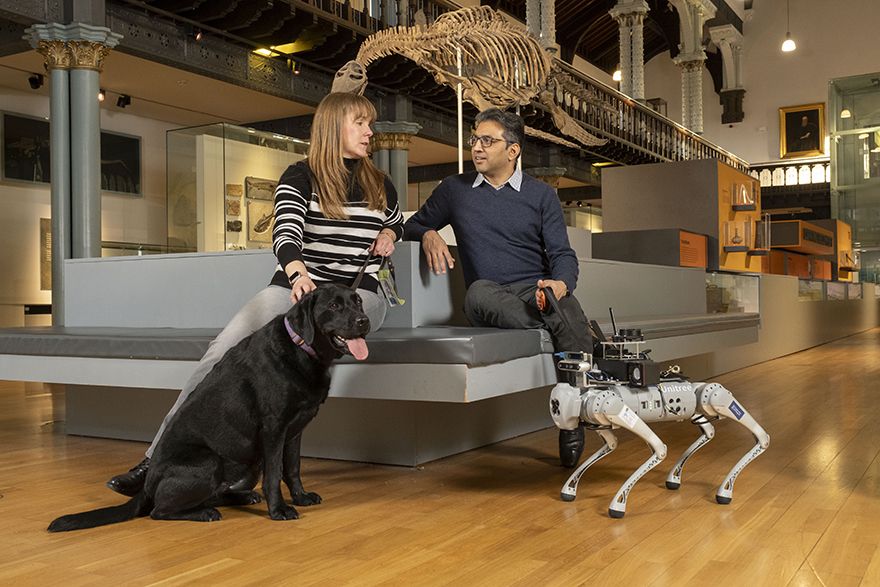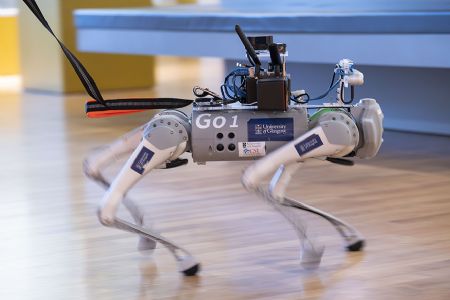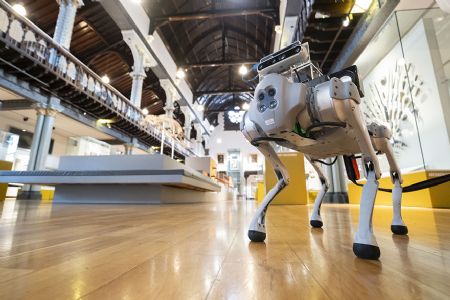
Blind and partially sighted people could soon receive help to find their way around indoor spaces from chatty robot guide dogs currently in development at a Scottish university. Engineers from the
University of Glasgow have partnered with industry and two leading charities to develop the RoboGuide, an AI-powered four-legged robot which aims to help visually impaired people move more independently through museums, shopping centres, hospitals and other public places in the future.
The RoboGuide prototype integrates a range of cutting-edge technologies into an off-the-shelf robot body to help overcome the challenges preventing robots from being more widely used to assist blind and partially sighted people. The project aims to bring a more complete version of the technology to market in the years to come to help support the 2.2 billion people around the world, and two million people in the UK, whose sight is impaired.
Prof Muhammad Imran, dean of graduate studies at the University of Glasgow’s James Watt School of Engineering, is co-investigator on the project. He said: “Our assistive technology project for the visually impaired embodies innovation, fostering inclusivity. In Glasgow, we are pioneering world-changing technologies that hold the potential to transform lives and reshape societal norms. This achievement was made possible through collaboration with industry and charity partners and co-creating the design with the invaluable input of end users.”
More independenceDr Olaoluwa Popoola, of the University of Glasgow’s James Watt School of Engineering, is the RoboGuide project’s principal investigator. He said: “Assistive technologies like the RoboGuide have the potential to provide blind and partially sighted people with more independence in their daily lives in the future.

“One significant drawback of many current four-legged, two-legged and wheeled robots is that the technology which allows them to find their way around can limit their usefulness as assistants for the visually impaired.
“Robots which use GPS to navigate, for example, can perform well outdoors, but often struggle in indoor settings, where signal coverage can weaken. Others, which use cameras to ‘see’, are limited by line of sight, which makes it harder for them to safely guide people around objects or around bends.”
The RoboGuide system uses a series of sophisticated sensors mounted on the robot’s exterior to accurately map and assess its surroundings. Software developed by the team help it learn the optimal routes between locations and interpret the sensor data in real-time to help the robot avoid the many moving obstacles it might encounter while guiding a human.
The RoboGuide also incorporates large language model technology, lending it the ability to understand questions and comments from users and provide verbal responses in return.
The
Forth Valley Sensory Centre (FVSC) Trust (FVSC) and the
Royal National Institute of Blind People (RNIB) Scotland have lent their support to the development of the RoboGuide.
In December, it was tested for the first time with volunteers from FVSC and RNIB at the Hunterian, Scotland’s oldest museum. The RoboGuide helped the volunteers find their way around the first floor of the museum, and provided interactive spoken guidance on six exhibits.
Real-world environmentsDr Wasim Ahmad, of the James Watt School of Engineering, is co-investigator on the project. He said: “We are pleased to be working closely with the FVSC and RNIB Scotland to test the RoboGuide in real-world environments, and to integrate their feedback into more refined iterations of the technology.

“Ultimately, our aim is to develop a complete system which can be adapted for use with robots of all shapes and sizes to help blind and partially sighted people in a wide range of indoor situations. We hope that we can create a robust commercial product which can support the visually impaired wherever they might want extra help.
Representatives from the FVSC and RNIB Scotland joined the Glasgow research team at the University of Glasgow’s Mazumdar-Shaw Advanced Research Centre on 8 February for an event showcasing the ongoing development of the RoboGuide.
Jacquie Winning, the chief executive of the FVSC, said: “Mobility is a big issue for the blind and partially sighted community. RoboGuide is a wonderful solution to that problem, and we are delighted to help test this innovative and creative robot. We are pleased to play our part in helping to harness the power of new technology to improve the independence and confidence of people with sensory loss and make sure they can live their lives to the full.”
RNIB Scotland director James Adams said; “We are delighted to be supporting the research and development of technology that could be part of making the world more accessible and empowering blind and partially sighted people to live their lives confidently.
“Technology innovations like this are reshaping the future of accessibility and this partnership demonstrates their burgeoning potential to create a more inclusive world.”
The nine-month research project is supported by funding from the Engineering and Physical Sciences Research Council (EPSRC), part of
UKRI, through the Impact Acceleration Account programme.